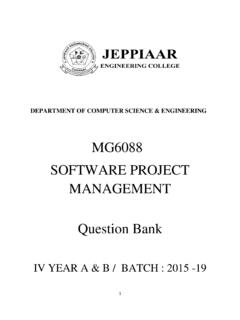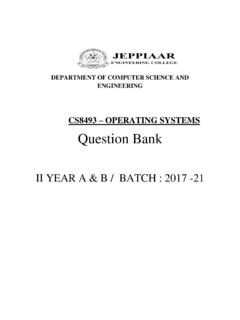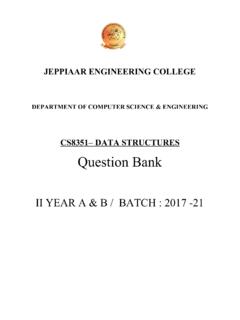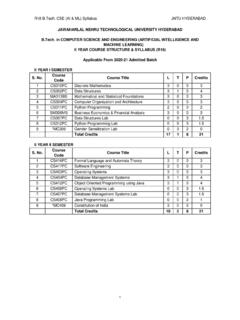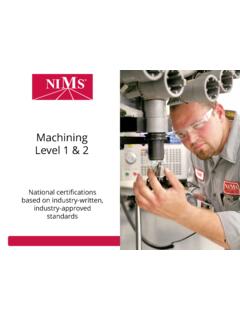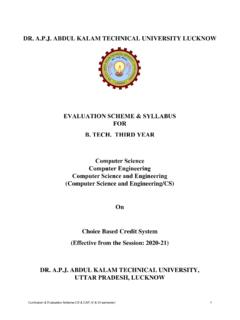Transcription of CS8352 Digital Principles and system Design Question Bank
1 JEPPIAAR ENGINEERING COLLEGE DEPARTMENT OF COMPUTER SCIENCE & ENGINEERING CS8352 Digital Principles and system Design Question Bank II YEAR A & B / BATCH : 2017 -2021 (common for CSE &IT) Vision of Institution To build Jeppiaar Engineering College as an Institution of Academic Excellence in Technical education and Management education and to become a World Class University. Mission of Institution M1 To excel in teaching and learning , research and innovation by promoting the Principles of scientific analysis and creative thinking M2 To participate in the production, development and dissemination of knowledge and interact with national and international communities M3 To equip students with values, ethics and life skills needed to enrich their lives and enable them to meaningfully contribute to the progress of society M4 To prepare students for higher studies and lifelong learning , enrich them with the practical and entrepreneurial skills necessary to excel as future professionals and contribute to Nation s economy Program Outcomes (POs) PO1 Engineering Knowledge.
2 Apply the Knowledge of mathematics, science, engineering fundamentals, and an engineering specialization to the solution of complex engineering problems. PO2 Problem analysis: Identify, formulate, review research literature, and analyze complex engineering problems reaching substantiated conclusions using first Principles of mathematics, natural sciences, and engineering sciences. PO3 Design /development of solutions: Design solutions for complex engineering problems and Design system components or processes that meet the specified needs with appropriate consideration for the public health and safety, and the cultural, societal, and environmental considerations PO4 Conduct investigations of complex problems: Use research-based Knowledge and research methods including Design of experiments, analysis and interpretation of data, and synthesis of the information to provide valid conclusions.
3 PO5 Modern tool usage: Create, select, and apply appropriate techniques, resources, and modern engineering and IT tools including prediction and modeling to complex engineering activities with an understanding of the limitations. PO6 The engineer and society: Apply reasoning informed by the contextual Knowledge to assess societal, health, safety, legal and cultural issues and the consequent responsibilities relevant to the professional engineering practice. PO7 Environment and sustainability: Understand the impact of the professional engineering solutions in societal and environmental contexts, and demonstrate the Knowledge of, and need for sustainable development. PO8 Ethics: Apply ethical Principles and commit to professional ethics and responsibilities and norms of the engineering practice.
4 PO9 Individual and team work: Function effectively as an individual, and as a member or leader in diverse teams, and in multidisciplinary settings. PO10 Communication: Communicate effectively on complex engineering activities with the engineering community and with society at large, such as, being able to comprehend and write effective reports and Design documentation, make effective presentations, and give and receive clear instructions. PO11 Project management and finance: Demonstrate Knowledge and understanding of the engineering and management Principles and apply these to one s own work, as a member and leader in a team, to manage projects and in multidisciplinary environments. PO12 Life-long learning : Recognize the need for, and have the preparation and ability to engage in independent and life-long learning in the broadest context of technological change.
5 Vision of Department To emerge as a globally prominent department, developing ethical computer professionals, innovators and entrepreneurs with academic excellence through quality education and research. Mission of Department M1 To create computer professionals with an ability to identify and formulate the engineering problems and also to provide innovative solutions through effective teaching learning process. M2 To strengthen the core-competence in computer science and engineering and to create an ability to interact effectively with industries. M3 To produce engineers with good professional sKills, ethical values and life skills for the betterment of the society. M4 To encourage students towards continuous and higher level learning on technological advancements and provide a platform for employment and self-employment.
6 Program Educational Objectives (PEOs) PEO1 To address the real time complex engineering problems using innovative approach with strong core computing skills. PEO2 To apply core-analytical Knowledge and appropriate techniques and provide solutions to real time challenges of national and global society PEO3 Apply ethical Knowledge for professional excellence and leadership for the betterment of the society. PEO4 Develop life-long learning skills needed for better employment and entrepreneurship SYLLABUS UNIT I BOOLEAN ALGEBRA AND LOGIC GATES 12 Number Systems - Arithmetic Operations - Binary Codes- Boolean Algebra and Logic Gates - Theorems and Properties of Boolean Algebra - Boolean Functions - Canonical and Standard Forms - Simplification of Boolean Functions using Karnaugh Map - Logic Gates NAND and NOR Implementations.
7 UNIT II COMBINATIONAL LOGIC 12 Combinational Circuits Analysis and Design Procedures - Binary Adder-Subtractor - Decimal Adder - Binary Multiplier - Magnitude Comparator - Decoders Encoders Multiplexers - Introduction to HDL HDL Models of Combinational circuits. UNIT III SYNCHRONOUS SEQUENTIAL LOGIC 12 Sequential Circuits - Storage Elements: Latches , Flip-Flops - Analysis of Clocked Sequential Circuits - State Reduction and Assignment - Design Procedure - Registers and Counters - HDL Models of Sequential Circuits. UNIT IV ASYNCHRONOUS SEQUENTIAL LOGIC 12 Analysis and Design of Asynchronous Sequential Circuits Reduction of State and Flow Tables Race-free State Assignment Hazards. UNIT V MEMORY AND PROGRAMMABLE LOGIC 12 RAM Memory Decoding Error Detection and Correction - ROM - Programmable Logic Array Programmable Array Logic Sequential Programmable Devices.
8 TEXT BOOK: 1. M. Morris R. Mano, Michael D. Ciletti, Digital Design : With an Introduction to the Verilog HDL, VHDL, and SystemVerilog , 6th Edition, Pearson Education, 2017. REFERENCES: 1. G. K. Kharate, Digital Electronics, Oxford University Press, 2010 2. John F. Wakerly, Digital Design Principles and Practices, Fifth Edition, Pearson Education, 2017. 3. Charles H. Roth Jr, Larry L. Kinney, Fundamentals of Logic Design , Sixth Edition, cengage learning , 2013 4. Donald D. Givone, Digital Principles and Design , Tata Mc Graw Hill, 2003. course Outcomes (COs) Simplify Boolean functions using KMap Design Analyze Combinational and Sequential Circuits Implement designs using Programmable Logic Devices Write HDL code for combinational Circuits Write HDL code for Sequential Circuits BLOOM TAXANOMY LEVELS BTL1: Creating.
9 , BTL2: Evaluating., BTL3: Analyzing., BTL4: Applying., BTL5: Understanding., BTL6: Remembering JEPPIAAR ENGINEERING COLLEGE Jeppiaar Nagar, Rajiv Gandhi Salai 600 119 DEPARTMENT OF COMPUTER SCIENCE AND ENGINEERING Question BANK SUBJECT: CS8351 Digital Principles AND system Design YEAR /SEM: II/III UNIT I BOOLEAN ALGEBRA AND LOGIC GATES Number Systems - Arithmetic Operations - Binary Codes- Boolean Algebra and Logic Gates - Theorems and Properties of Boolean Algebra - Boolean Functions - Canonical and Standard Forms - Simplification of Boolean Functions using Karnaugh Map - Logic Gates NAND and NOR Implementations. PART A CO Mapping : S. No. Question Blooms Taxanomy Level Competence PO 1 Find the Octal equivalent of the hexadecimal number (May/June 2016) BTL-5 Evaluating PO1, PO2, PO3 2 What is meant by multilevel gates networks?
10 (May/June 2016) BTL-1 Remembering PO1 3 Discuss the NOR operation with a truth table. ( 2015) BTL-1 Remembering PO1 4 Write short notes on weighted binary codes. ( 2015) BTL-1 Remembering PO1 5 Convert (126)10 to Octal number and binary number. ( 2015) BTL-1 Remembering PO1 6 Prove the following using Demorgan theorem [(X+Y) +(X+Y) ] = X+Y (May 2015) BTL-1 Remembering PO1 7 Convert ( )10 to binary. (May 2015) BTL-1 Remembering PO1 8 Implement AND gate using only NOR gate (December 2014) BTL-1 Remembering PO1 9 State the principle of duality (December 2014) BTL-1 Remembering PO1 10 State and prove the consensus theorem. (June 2014) BTL-1 Remembering PO1 11 Find the octal equivalent of hexadecimal numbers (June 2014) BTL-1 Remembering PO1 12 Realize XOR gate using only 4 NAND gates.

